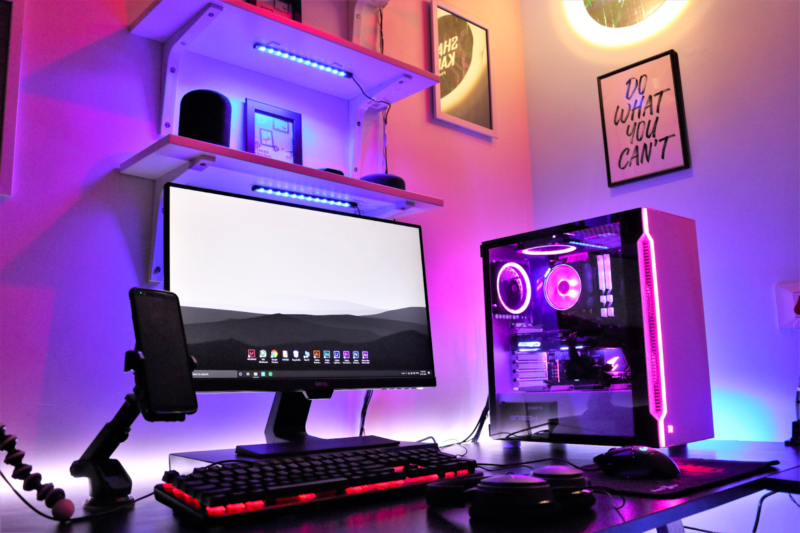As the landscape of PC customization evolves, it brings with it a myriad of ways to personalize our tech experience. From performance tuning to aesthetic refinement, there’s one aspect that truly allows a PC to shine – its lighting. One term that stands at the forefront of this illumination revolution is ARGB, or Addressable RGB.
In this comprehensive guide, we will delve into everything you need to know about ARGB – what it is, how it works, where it is used, and how it differs from other lighting standards like RGB and VDG.
Without any further ado, let’s dive deeper into this radiant world of ARGB, and discover how it’s lighting up the realm of device personalization.
TABLE OF CONTENTS
What is ARGB?

ARGB, also known as Addressable RGB, represents a significant evolution in the world of lighting technology. This system is particularly popular in the gaming and computer customization fields where vibrant and dynamic light displays can greatly enhance user experience. Before we delve into the specifics of ARGB, let’s first explore its foundation – the RGB color model.
The RGB color model is a well-known and widely-used system for electronic displays, like television screens and computer monitors. It is an additive model where the colors Red, Green, and Blue are combined in various proportions to reproduce a broad spectrum of colors.
However, the conventional RGB setup has its limitations. It operates as a single unit where all LEDs share the same color and intensity at any given moment. This is where ARGB comes in to provide a more sophisticated and versatile approach.
ARGB, or Addressable RGB, is a lighting interface that allows individual control of each light source in an array of RGB LEDs. This key feature of ARGB – the “addressability” – means that each LED (or ‘pixel’) can be controlled independently and display a different color and brightness level from its neighbors. This functionality is what separates ARGB from traditional RGB and it opens up the possibility for creating complex, vibrant, and highly customized lighting patterns.
Whether you’re a gamer looking to enhance your experience, a computer enthusiast wanting to customize your setup, or a professional in the lighting industry seeking to create more complex patterns, ARGB offers a wealth of opportunities.
How Does ARGB Work?
In essence, the working principle of ARGB, or Addressable RGB, is founded on the transmission and interpretation of data. Understanding how it functions involves a closer look at the unique characteristics of ARGB connectors, the distinction between input and output connectors, and the way signals are passed between devices to create complex lighting patterns.
ARGB Connectors
ARGB connectors typically consist of three pins and are a bit different from their classic RGB counterparts, which usually have four pins. The key difference here is that the ARGB system does away with one of the pins, which serves to maintain a degree of safety.
The three pins on an ARGB connector are typically designated for Ground (GND), Data (D), and Power (VDD, usually 5V). The ground pin is for the common ground, the power pin is for supplying voltage, and the data pin is used for data signal transmission, which differentiates each LED and allows them to be individually addressed.
Input and Output Connectors
ARGB LED strips usually feature two sets of connectors: input and output. The input connectors are where the ARGB signal from the motherboard or controller is received, while the output connectors are for transmitting the signal to another LED strip or device. The ability to string multiple devices together is what facilitates the creation of elaborate and synchronous lighting effects across a broad array of devices.
Signal Transmission and Complex Lighting Patterns
When an ARGB system is powered up and the data signal is transmitted, each LED in the strip receives the data signal, interprets it, then passes the remaining data signal to the next LED. The key point to note is that each LED only takes the data it needs from the beginning of the signal and then passes the rest along.
This method of passing the data signal allows for the creation of complex and intricate lighting patterns. Because each LED can receive individual instructions via the data signal, it’s possible to program a wide range of effects. For instance, one can make each LED display a different color, create moving color gradients, make lights pulse to the beat of music, among other effects.
Is VDG also ARGB?

VDG is a type of connector interface commonly found on certain motherboards, notably those manufactured by Gigabyte. The term VDG stands for Voltage (V), Data (D), and Ground (G), which are the three types of connections that this particular interface uses.
In essence, a VDG connector is used to link Addressable RGB (ARGB) devices, such as LED strips or fans, to the motherboard, enabling the control of lighting effects on these devices. The VDG interface enables individual control over each light in an ARGB setup, providing a range of customization options and facilitating the creation of complex lighting patterns.
The VDG connector itself is typically a 3-pin setup, similar to other ARGB interfaces. However, the naming of the pins – Voltage, Data, and Ground – is specific to the VDG nomenclature. Here’s what each of these pins does:
- Voltage (V): This is the power connection, usually running at +5V. This line supplies the power necessary for the connected LEDs to light up.
- Data (D): This is the line that carries the data signal from the motherboard to the connected ARGB devices. The data line controls the color and brightness of each individual LED.
- Ground (G): This is the common ground connection, completing the circuit and enabling the LEDs to function correctly.
It’s essential to note that while VDG connectors are fundamentally similar to other ARGB connectors, they may not always be directly compatible due to variations in pin layout or voltage levels. As such, when setting up ARGB systems, it’s crucial to ensure all components are compatible with each other to avoid potential damage.
Where Is ARGB Used?

ARGB, or Addressable RGB, has found its way into a multitude of devices and applications due to its versatility and the enhanced aesthetic experience it offers. It allows users to create a more interactive and immersive environment by controlling lighting at a granular level. Here are some areas where ARGB is commonly used:
ARGB in Memory
ARGB has become a popular feature in the realm of computer memory, particularly for RAM modules. High-end gaming and performance memory often incorporate ARGB lighting, allowing users to synchronize the illumination with other components in their computer. This doesn’t affect performance but does significantly enhance the visual appeal of the system.
ARGB in Motherboards
Motherboards, being the nerve center of any computing system, are another component where ARGB is often utilized. Some motherboards come with built-in ARGB headers and LED light strips, which can be customized to match the rest of the system. Moreover, having ARGB capabilities in motherboards enables easier control and synchronization of the lighting effects across all connected ARGB devices.
ARGB in Cooling Solutions
ARGB is also commonly used in PC cooling solutions, like fans and water cooling reservoirs. ARGB fans are particularly popular, as they can display a range of colors and effects while also providing essential cooling. Water cooling reservoirs with ARGB lighting not only make the reservoir visually striking but also allow the user to monitor the coolant level.
ARGB in Other Devices
Beyond these, ARGB lighting is also prevalent in a variety of peripherals and accessories. Keyboards, mice, headphone stands, and even gaming chairs are available with ARGB lighting. PC cases, graphic card holders, and even power supply shrouds can also come equipped with ARGB lighting, providing users with numerous ways to customize their setups.
ARGB Across Different Brands

ARGB, or Addressable RGB, technology is utilized by various major brands in the computer hardware industry, including Asus, ASRock, MSI, and Gigabyte. Each brand has its own approach to ARGB implementation, including how they name their ARGB headers and how they synchronize ARGB headers with onboard lighting features and memory modules.
Asus: Aura Sync
Asus uses the term Aura Sync to refer to its lighting control system. The brand’s motherboards come equipped with ARGB headers, which Asus refers to as “Addressable Gen 2 headers”. These headers support a multitude of ARGB devices, from fans and memory modules to LED strips and more.
Asus’s Aura Sync software allows users to control and synchronize the lighting on all Aura-enabled components. The software offers a variety of effects and also allows the lights to respond to music or CPU temperature, providing an immersive and dynamic experience.
ASRock: Polychrome Sync
ASRock has its own ARGB system known as Polychrome Sync. The brand’s motherboards feature ARGB headers which can be used to connect ARGB fans, coolers, and other devices. ASRock’s Polychrome Sync software allows users to control and synchronize the lighting effects across all compatible devices, creating a unified and visually striking system.
MSI: Mystic Light
MSI’s lighting control system is called Mystic Light. MSI motherboards are equipped with JRAINBOW headers for ARGB devices. With the Mystic Light software, users can control and synchronize the ARGB lighting on all compatible devices, from memory modules and fans to keyboards and other peripherals. The software offers various customization options, including synchronization with music or game effects.
Gigabyte: RGB Fusion
Gigabyte uses the RGB Fusion system for its lighting controls. The brand’s motherboards feature ARGB headers known as VDG headers. The RGB Fusion software enables users to control and synchronize the ARGB lighting across all compatible devices. The software also provides a range of lighting patterns and effects, allowing for an impressive degree of customization.
Pros and Cons of RGB, ARGB, and VDG
When it comes to PC customization, lighting plays a significant role, and standards like RGB, ARGB, and VDG are at the forefront. Each of these lighting standards has its own set of advantages and disadvantages, which we’ll delve into below.
RGB
Pros
- Simplicity: RGB systems are typically easier to install and use compared to ARGB or VDG. There are fewer pins to deal with, and the software control is usually straightforward.
- Compatibility: RGB is a widely adopted standard, so it’s relatively easy to find compatible parts and accessories.
- Cost: RGB components are often less expensive than their ARGB counterparts, making them an attractive option for budget-conscious users.
Cons
- Simplicity: RGB systems are typically easier to install and use compared to ARGB or VDG. There are fewer pins to deal with, and the software control is usually straightforward.
- Compatibility: RGB is a widely adopted standard, so it’s relatively easy to find compatible parts and accessories.
- Cost: RGB components are often less expensive than their ARGB counterparts, making them an attractive option for budget-conscious users.
ARGB
Pros
- Individual LED Control: ARGB stands for Addressable RGB, which allows for the individual control of each LED. This enables the creation of complex and varied lighting patterns, greatly enhancing customization possibilities.
- Advanced Lighting Effects: With individual LED control, you can create lighting effects that react to music, gameplay, and more, providing a more immersive experience.
Cons
- Installation Complexity: Setting up ARGB systems can be a bit more complex due to the extra data line and the need to ensure that each LED is correctly addressed.
- Cost: ARGB components are typically more expensive than standard RGB due to the additional technology required for individual LED control.
- Compatibility: Not all motherboards or controllers support ARGB, which can limit your options for expansion or upgrading.
VDG
Pros
- Individual LED Control: Like ARGB, VDG allows for the individual control of each LED, offering the same customization benefits.
- Compatibility with Gigabyte Motherboards: If you’re using a Gigabyte motherboard with VDG headers, you’ll have a straightforward installation process and solid compatibility.
Cons
- Brand-Specific: VDG is primarily found on Gigabyte motherboards, which can limit your choices if you’re using a different brand.
- Installation Complexity: Like ARGB, VDG systems can be complex to set up due to the individual addressing of LEDs.
Overall, the choice between RGB, ARGB, and VDG depends largely on your specific needs, budget, and the level of customization you desire. RGB offers simplicity and affordability, ARGB provides advanced control and customization, and VDG offers similar benefits to ARGB but is typically associated with Gigabyte hardware.
Frequently Asked Questions
Here are some frequently asked questions related to ARGB:
How many colors are in 100% RGB?
A 100% RGB color model can create 16,777,216 distinct colors. This is calculated by multiplying the highest possible values for each of the Red, Green, and Blue channels (which is 256 for each channel in an 8-bit per channel system) together: 256 x 256 x 256 = 16,777,216.
How many LEDS can ARGB handle?
In most cases, ARGB can handle multiple addressable RGB devices, but there are typically limitations on the number of LEDs that can be connected. Each ARGB port or header can usually support up to 80 LEDs, and the total number of LEDs across all ports is often capped at around 240.
Final Words: The Significance of ARGB
ARGB, or Addressable RGB, provides enhanced customization in digital devices, enabling individual control of lights for intricate lighting patterns. It is used across many devices, including motherboards, memory modules, and fans, among others. Major brands like Asus, ASRock, MSI, and Gigabyte implement ARGB uniquely in their systems.
Compared to RGB and VDG, ARGB stands out for its advanced control, though it’s more complex to install and usually costlier. RGB offers simplicity and affordability but lacks in customization, while VDG, similar to ARGB, is specific to Gigabyte hardware.
In summary, understanding ARGB is crucial for PC customization enthusiasts, as it allows for more immersive and personalized lighting effects. Its significance is expected to grow as lighting technology advances.
